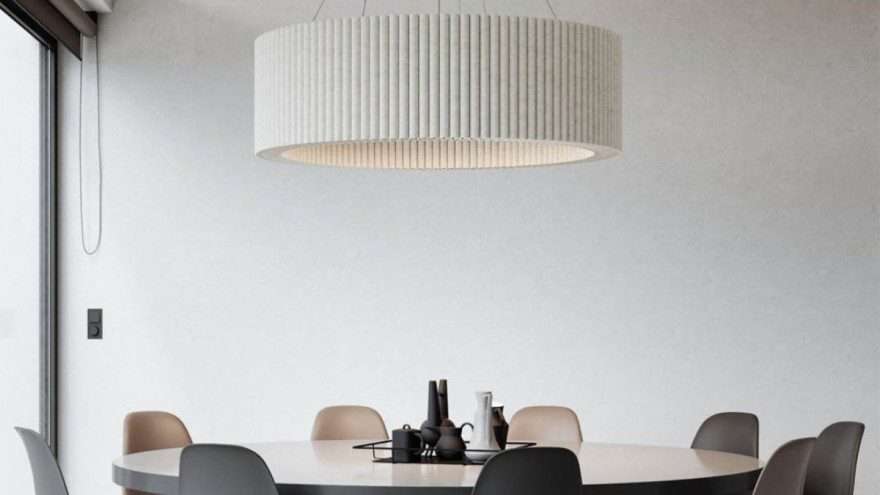The way we perceive the acoustics in a room depends on many factors that are often unnoticed.
However, the room’s acoustics are critical to the interior ambiance and the sense of luxury it provides.
It should therefore be considered from the very beginning in architectural and interior design. Stylish acoustic reflectors and the right combination of materials and modern acoustic furniture can improve the acoustics of a room, and can be seamlessly integrated into the overall interior décor.

What affects the acoustic properties of a room?
At first, sound waves spread evenly in the air, but that changes if they encounter a barrier: they are reflected, absorbed, or scattered randomly.
While hard surfaces, such as concrete or glass, reflect sound back into the room with relatively little loss, soft, porous materials act as sound absorbers.
Sound isolation can also stop waves in a certain way, reducing frequencies that might be perceived as disturbing, for example, so sound can be effectively controlled.
Most materials combine many of these properties, in addition,
Interior designers can use different items of furniture, floor coverings and wall decorations to give a room unique acoustic characteristics.
While most workplaces and home offices must absorb noise, a university lecture hall is designed for clear speech.
By contrast, restaurants aim to promote an intimate atmosphere around the table, even in large venues.
But sound is not just for public rooms like this, as it must also be taken into account when designing spacious living rooms with high ceilings.
Because although they may be invisible, sound waves and how they travel help determine the atmosphere inside.
Interior design for perfect room acoustics
Every room is different, and so is the individual perception of sound. Audiologists may have methods for measuring echoes, speech transmission, sound isolation, and sound intelligibility.
But there are no universal guidelines on how to improve the acoustics in a room.
Depending on the intended use and desired ambiance, acoustic reflectors, a heavy wool rug or solid wood furniture could be the right choice for individual interior sound creating an atmosphere of well-being.

Textiles and wall coverings
Sound insulation today provides more than heavy curtains or egg crates on the walls of student band practice rooms.
But the basic idea is still the same: Textiles, such as rugs, curtains, and sofa covers, absorb sound waves much better than hard surfaces.
Wallcoverings made of wool felt, jute or recycled polyester have been in trend for some time.
Whisperwool by Tante Lotte Design is made from the wool of sustainable Tyrolean sheep and has gentle insulating properties.
While the cheerful colors of the Beetle from Sancal Diseño make it perfect for a nursery.
The Aline wall panel by Yeseco Oy not only improves the acoustics in the room but also gives the wall a unique character.
The triangle-based arrangement is based on the idea of an old egg carton using different structures.
They are often asymmetric for the scattering of sound waves,
This creates a pleasant effect by attenuating particularly high or low sound frequencies.
Those who prefer an especially natural look can choose styleGREEN easy-care Iceland moss to decorate bare walls, while also maximizing surface area to dampen unwanted noise.
room dividers
Now of course in large offices, acoustic room dividers are increasingly finding their way into home offices.
In addition to providing visual privacy to aid distraction-free work,
That mobile units give people on both sides of the section the advantage of sound insulation.
Designs – such as the Divi put.on sound absorber from Ropimex or the Wave acoustic screen from Yeseco Oy – have been developed
Made with modern interiors in mind and never looks out of place in home living rooms.
acoustic furniture
In addition to the natural sound-absorbing properties of sofas, tables, etc.,
More and more manufacturers are specifically developing furniture and interior items that provide improved room acoustics.
Hardly outwardly distinguishable from ordinary lamps or seating furniture, these pieces have a greater impact on sound transmission thanks to their surface structure or the materials used.
Also pendant lights such as HEY-SIGN wave ceiling object,
Corrugated felt lampshade with sound-absorbing effect, ideal for rooms with high ceilings.
One example of a design suitable for modern office buildings is the BuzziZepp LED Line from Buzzispace,
Which provides visual and acoustic control of open spaces.
For home offices, Vital-Office’s vitAcoustic Burial Door Cabinets can provide sound insulation,
The EarChair by Prooff is a reinterpretation of the wing chair.
It works like a cocoon to protect from external sounds and other influences.
Anyone who is still not convinced by the high quality design of acoustic furniture will surely find proof in this statement piece.
For more architectural news


 العربية
العربية
